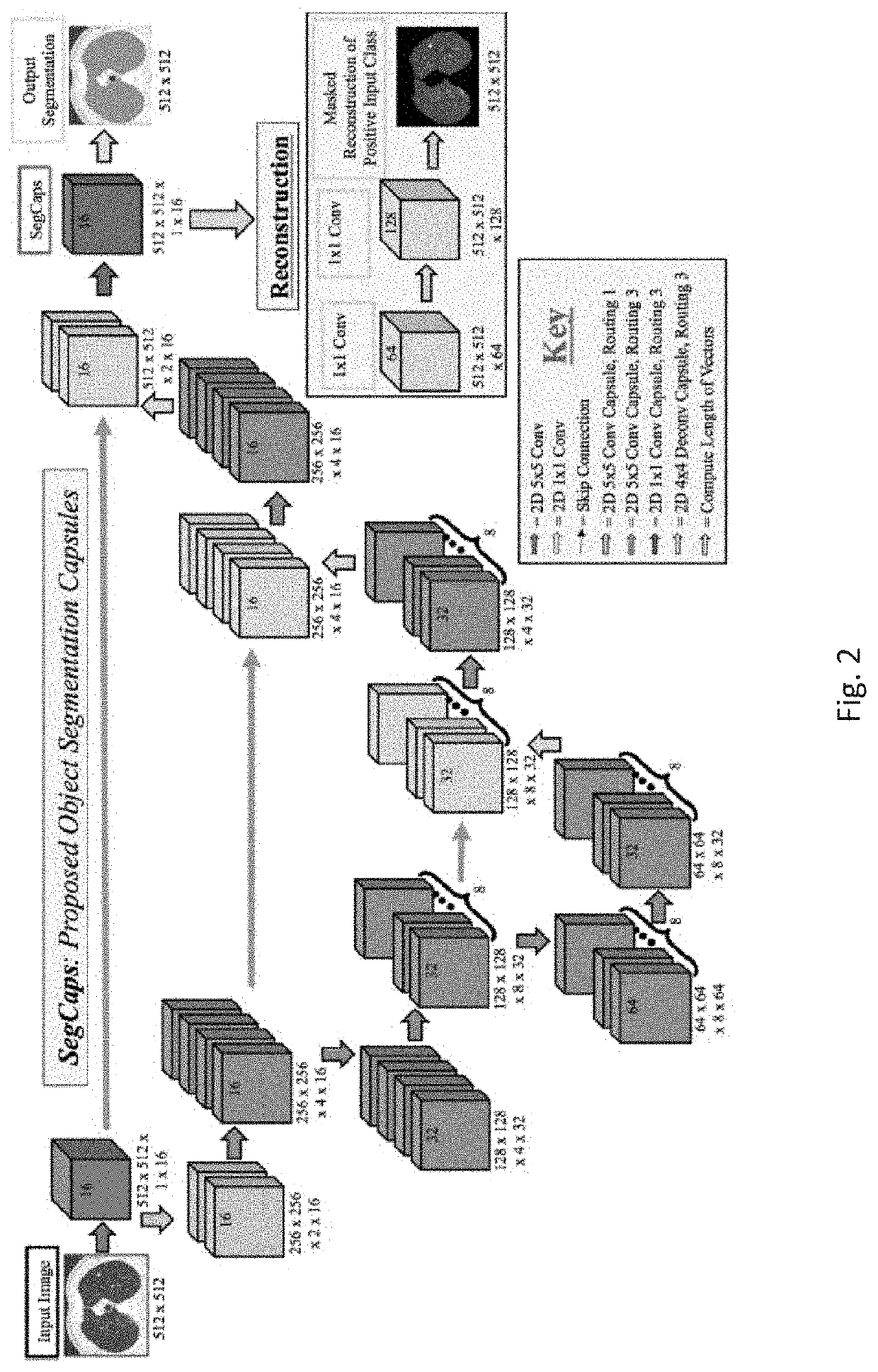Capsules for image analysis
a technology of image analysis and capsules, applied in image analysis, image enhancement, kernel methods, etc., can solve the problems that the real-time optical biopsy of colon polyps with narrow band imaging in community practice does not yet meet key thresholds for clinical decisions, and the image analysis network of capsules with interpretable vectors is not yet applied in clinical practice. achieve the effect of reducing space, time and monetary costs, and increasing the accuracy of object segmentation methods
- Summary
- Abstract
- Description
- Claims
- Application Information
AI Technical Summary
Benefits of technology
Problems solved by technology
Method used
Image
Examples
example 1
[0044]Experiments were conducted on the LUNA16 subset of the LIDC-IDRI database, randomly split into four training / testing folds for performing k-fold cross-validation. The LUNA 16 subset contains a range of lung CT scans from severe to no pathologies present. Ground-truth annotations were provided in the form of segmentation masks created by an automated algorithm (van Rikxoort et al. [22]). Manual inspection led to the removal of 10 of the 888 CT scans due to exceedingly poor annotations. Because of the lack of expert human-annotations, the proposed methods and baselines were observed to typically outperform these ground-truth segmentation masks for particularly difficult scans. This, in turn, lead to higher dice scores for worse performance in those cases, as they typically failed in a similar way. To compensate for such outliers, all numeric results are reported in terms of median rather than mean averages.
[0045]U-Net, Tiramisu, the three-layer baseline capsule segmentation netw...
example 2
[0051]Colorectal cancer is one of the leading causes of cancer-related death worldwide, with the majority of colorectal cancer cases arising from precursor legions that are referred to as polyps. These polyps are typically classified into one of three categories: 1) hyperplastic; 2) serrated (comprised of sessile serrated adenomas and traditional serrated adenomas); and 3) adenomas. Hyperplastic polyps are considered benign and can safely be left in situ; however, serrated polyps and adenomas are considered premalignant and should be resected during colonoscopy. Typically, polyp diagnosis and classification is performed by taking a sample and performing a histopathological analysis, commonly referred to as a biopsy. However, biopsies are time-consuming and expensive, and can present perforation and bleeding risks for some patients. As such, it is desirable to provide an optical method of analyzing a polyp to efficiently and safely determine whether a polyp is likely to be benign, or...
example 3
[0066]Lung cancer is the leading cause of cancer-related deaths in both men and women, and is incurable in the majority of cases due to the advanced stage at the time of most diagnoses. The National Lung Screening Trial (NLST) showed that screening patients with low-dose computed tomography (CT) has reduced lung cancer specific mortality by 20% [32, 33]. Despite this promising increase in screening technology, only 16% of lung cancer cases are diagnosed at an early stage [34]. The reasons behind this low diagnosis rate at an early stage are due to the screening / diagnosis related challenges including (a) high false positive rates, (b) over-diagnosis, and (c) missed tumors during screening [35]. Based on DL models such as 2D and 3D deep convolutional neural networks (CNN), there have been large number of studies conducted to alleviate these challenges [36-46], and such explorations were partially successful and improved both nodule detection and image-based diagnostic rates drasticall...
PUM
 Login to View More
Login to View More Abstract
Description
Claims
Application Information
 Login to View More
Login to View More - R&D
- Intellectual Property
- Life Sciences
- Materials
- Tech Scout
- Unparalleled Data Quality
- Higher Quality Content
- 60% Fewer Hallucinations
Browse by: Latest US Patents, China's latest patents, Technical Efficacy Thesaurus, Application Domain, Technology Topic, Popular Technical Reports.
© 2025 PatSnap. All rights reserved.Legal|Privacy policy|Modern Slavery Act Transparency Statement|Sitemap|About US| Contact US: help@patsnap.com



